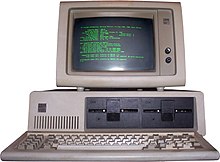In what was later to be called The Mother of All Demos, SRI researcher Douglas Englebart in 1968 gave a preview of what would become the staples of daily working life in the 21st century - e-mail, hypertext, word processing, video conferencing, and the mouse. The demonstration required technical support staff and a mainframe time-sharing computer that were far too costly for individual business use at the time.
By the early 1970s, people in academic or research institutions had the opportunity for single-person use of a computer system in interactive mode for extended durations, although these systems would still have been too expensive to be owned by a single person.
Early personal computers — generally called microcomputers — were sold often in kit form and in limited volumes, and were of interest mostly to hobbyists and technicians. Minimal programming was done with toggle switches to enter instructions, and output was provided by front panel lamps. Practical use required peripherals such as keyboards, computer terminals, disk drives, and printers. Micral N was the earliest commercial, non-kit microcomputer based on a microprocessor, the Intel 8008. It was built starting in 1972 and about 90,000 units were sold. The first true Personal Computer was the Sphere 1 computer, created in Bountiful, Utah in 1975 by computer pioneer Michael D. Wise (1949–2002). At first, Sphere 1 was sold as a kit, but was later sold as fully assembled PC. The Sphere 1 qualified as The First Personal Computer because it included a keyboard, a number pad, and a monitor. In 1976 Steve Jobs and Steve Wozniak sold the Apple I computer circuit board, which was fully prepared and contained about 30 chips. The first successfully mass marketed personal computer was the Commodore PET introduced in January 1977, which bore a striking resemblance to Sphere 1 of two years earlier. It was soon followed by the TRS-80 from Radio Shack and the popular Apple II. Mass-market ready-assembled computers allowed a wider range of people to use computers, focusing more on software applications and less on development of the processor hardware.
Through the late 1970s and into the 1980s, computers were developed for household use, with software for personal productivity, programming and games. One such machine, the Commodore 64, totaled 17 million units sold, making it the best-selling single personal computer model of all time.[3] Somewhat larger and more expensive systems (although still low-cost compared with minicomputers and mainframes) were aimed at office and small business use. Workstations are characterized by high-performance processors and graphics displays, with large local disk storage, networking capability, and running under a multitasking operating system.

In 1982 "The Computer" was named Machine of the Year by Time Magazine.







0 comments:
Post a Comment